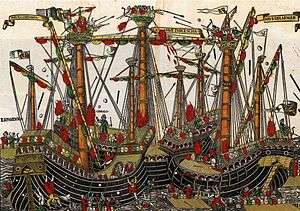Battle of Zonchio
| Battle of Zonchio | |||||||
|---|---|---|---|---|---|---|---|
| Part of the Ottoman–Venetian War of 1499–1503 | |||||||
 unknown Venetian artist, British Museum | |||||||
| |||||||
| Belligerents | |||||||
|
| Ottoman Empire | ||||||
| Commanders and leaders | |||||||
| Antonio Grimani | Kemal Reis | ||||||
| Strength | |||||||
|
47 galleys, 17 galliots, about 100 small vessels |
67 galleys, 20 galliots, about 200 small vessels | ||||||
The naval Battle of Zonchio (Turkish: Sapienza Deniz Muharebesi, also known as the Battle of Sapienza or the First Battle of Lepanto) took place on four separate days: 12, 20, 22 and 25 August 1499. It was a part of the Ottoman–Venetian War of 1499–1503.[2] It was the first naval battle in history where cannons were used on ships.
In January 1499 Kemal Reis set sail from Constantinople with a force of 10 galleys and 4 other types of ships, and in July 1499 met with the huge Ottoman fleet which was sent to him by Davud Pasha and took over its command in order to wage a large scale war against the Republic of Venice. The Ottoman fleet consisted of 67 galleys, 20 galliots and about 200 smaller vessels.
After reaching Cape Zonchio in the Ionian Sea with the large Ottoman fleet in August 1499, Kemal Reis defeated the Venetian fleet of 47 galleys, 17 galliots and about 100 smaller vessels under the command of Antonio Grimani. Grimani was 65 and although being a proven captain in battle, he was not an experienced leader and had never commanded large battle fleets. He had only been given command because of a donation of 16,000 ducats to the state and personally funding the arming of 10 galleys. He was not told whether to fight an offensive or defensive campaign. Many captains ignored his orders to attack the Ottomans and he did not take part in the battle. His indecisiveness and reluctance to attack led to failure during the battle.
On the second day, Grimani ordered the crews to kill any captains who refused to fight. Despite this, and the arrival of 4 French Galleys he sent just 2 galleys out of 170 against the Ottomans. Both somehow returned unharmed.
On 25 August the Venetians captured some Ottoman galleys, then discipline broke down and the Ottomans recaptured the vessels while they were being looted, the French reinforcements abandoned the Venetians in disgust and fled to Rhodes.
During the most critical stage of the battle, two Venetian carracks, captained by Andrea Loredan (a member of the influential Loredan family of Venice) and by Alban d'Armer, boarded one of the command ships of the Ottoman fleet. The commander of the vessel, Burak Reis, was unable to disentangle his ship from the boarders and chose to set her aflame. The sight of the three great ships burning together dealt a severe blow to the Venetian morale.[3]
Antonio Grimani was arrested on 29 September and banished to the island of Cherso. Grimani later became the Doge of Venice in 1521. The Ottoman Sultan Bayezid II gave 10 of the captured Venetian galleys to Kemal Reis, who later stationed his fleet at the island of Cefalonia between October and December, 1499.
The Ottomans and Venetians soon confronted each other for a second time at the Second Battle of Lepanto, which is also known as the Battle of Modon, and the Ottomans were victorious under Admiral Kemal Reis.
See also
References
- ↑ Stella Fletcher, The Longman Companion to Renaissance Europe, 1390-1530, (Routledge, 2013), 37.
- ↑ Norwich, John J. (2003) A History of Venice Penguin, London, pages 383–385, ISBN 978-0-14-101383-1, reprint of the 1977, 2 volume, edition, entitled Venice: the rise to empire and Venice: the greatness and the fall
- ↑ Fisher, Sydney N. The Foreign Relation of Turkey, 1481-1512. Chapter 6..
External links
- Sydney N. Fisher: The Foreign Relation of Turkey, 1481-1512, Chapter VI: War with Venice, 1499-1503
- John E. Dotson: Foundations of Venetian Naval Strategy from Pietro II Orseolo to the Battle of Zonchio
Coordinates: 36°54′N 21°41′E / 36.900°N 21.683°E